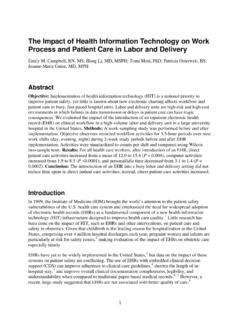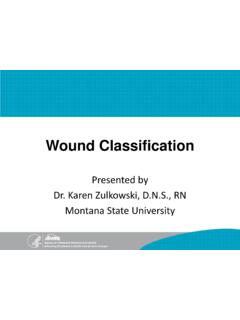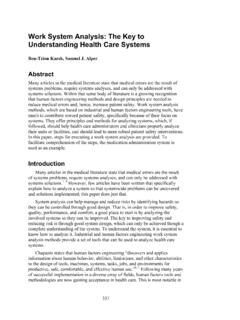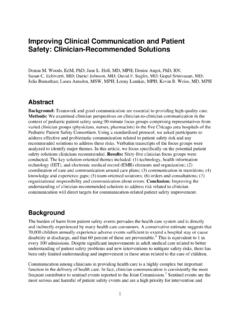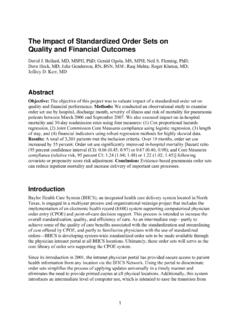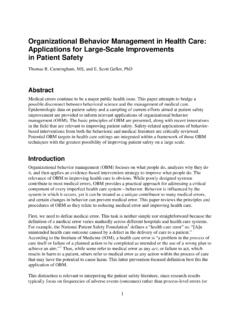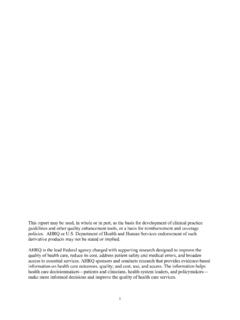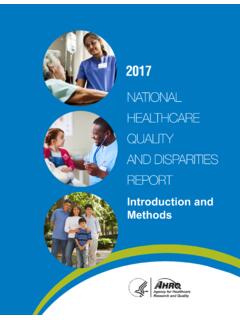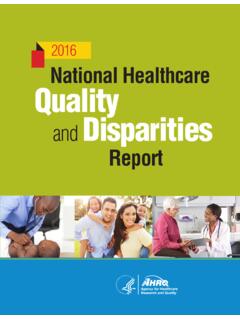Transcription of TeamSTEPPS Speciality Scenarios, Labor & Delivery
1 TeamSTEPPS Specialty scenarios - 103 Specialty scenarios L&D Specialty scenarios - 104 TeamSTEPPS Specialty scenarios L&D Scenario 85 Appropriate for: L&D Setting: Hospital Sue Jones a 28-year-old G1 P0 at term is undergoing an induction of Labor for elevated blood pressure. The patient is receiving 14 mu of Pitocin and is experiencing contractions every 3 minutes. The fetal heart rate has a baseline of 150 bpm with recurrent variable decelerations. Her cervix is dilated 4-5 cm, and it has not changed in more than an hour. The attending obstetrician asks the primary registered nurse (RN) to increase the rate of Pitocin.
2 The RN expresses her concerns about the variable decelerations and states there are adequate contractions. The attending obstetrician (OB) says, The baby is OK; push the Pitocin. The RN is uncomfortable with the request. She again expresses her concerns regarding the variable decelerations but does acknowledge that the patient may need stronger contractions. She informs the attending OB that if she had more information on the baby s well-being obtained with a fetal scalp electrode (FSE) and an intrauterine pressure catheter (IUPC), she would feel more comfortable increasing the infusion of Pitocin.
3 The attending OB agrees to this plan and places the FSE and IUPC. The RN slowly increases the Pitocin and the patient has a vaginal Delivery . Instructor Comments In this scenario, the RN expresses her concern about the physician s request and offers an alternative after using the Two-Challenge rule. A favorable outcome ensues because she advocates for the patient. Skills Needed Communication. Situation monitoring: assess status of patient. Situation awareness. Potential Tools Conflict resolution, Two-Challenge rule, Advocacy/assertion, Collaboration TeamSTEPPS Specialty scenarios - 105 Specialty scenarios L&D Scenario 86 Appropriate for: L&D Setting: Hospital Sally Rodgers, a 25-year-old nullip in Labor at term who is dilated 3 cm.
4 This is a change from 2 cm over the previous 90 minutes. Sally is having frequent, strong to palpation contractions that are extremely uncomfortable. She is trembling, complaining of nausea, and begging her nurse for pain relief. The patient s primary nurse believes epidural anesthesia would be appropriate and informs the obstetrician (OB) attending. The OB attending states he wants the patient to be dilated 4 5 cm before she receives the epidural. The nurse reiterates to the attending OB that her assessment is that the patient is in active Labor .
5 Although Sally s cervix has not demonstrated active Labor yet, her nurse believes the pain relief and relaxation resulting from an epidural would be beneficial for the patient. The attending OB agrees to the epidural placement. The patient is fully dilated and begins pushing 3 hours after the placement. Instructor Comments In this scenario, the primary nurse uses the Two-Challenge rule to advocate for a position different from that of the OB. She assertively provides information received through situation monitoring that supports her assessment that the patient should receive pain medication.
6 Skills Needed Communication. Situation monitoring: assess status of patient. Situation awareness. Potential Tools Conflict resolution, Two-Challenge rule, Advocacy/assertion, Collaboration Specialty scenarios - 106 TeamSTEPPS Specialty scenarios L&D Scenario 87 Appropriate for: L&D Setting: Hospital (To be read prior to discussions and slide presentation) Athena Onassis, a 36-year-old Greek-speaking G1 P0 with an in vitro fertilization (IVF) gestation at 27 weeks is admitted to L&D at 0200 from the antepartum unit with preterm Labor .
7 She is started on magnesium sulfate, and the contractions stop. Her vaginal exam at this time shows she is dilated 1 cm. The patient is transferred back to the antepartum unit at 0800. At 0915, the nurse from the antepartum unit calls the resident to come and see the patient because she is uncomfortable. The resident examines the patient and finds her to be dilated 3 cm. The attending physician is called, and the decision is made to transfer her back to L&D and perform a primary C-section (c/s). On arrival to L&D, the patient is brought to the recovery room, and the attending physician tells the charge nurse that it is not an emergent c/s and they can wait for Operating Room (OR) B to be available.
8 An interpreter is requested. Another attending physician who speaks Greek happens to be on L&D visiting one of her patients. She is asked to act as interpreter and, because of the language barrier, is asked to perform an ultrasound and a vaginal exam on the patient. Unexpectedly she finds the patient to be 4 5 cm dilated and in an urgent clinical situation. She tells the nurse that they must go back to the OR right away, but she does not call the attending physician. The nurse states that they are waiting for the patient s husband to arrive and does not call the attending physician.
9 The urgency of the situation is finally communicated to the appropriate people, and an emergent c/s is performed. The patient is examined in the OR and is dilated 7 cm. It is a very difficult Delivery requiring a pushup from below. Seven minutes pass between uterine incision and the Delivery of the baby. The baby dies from ventricular hemorrhage caused by trauma. Instructor Comments In this scenario, there is a barrier to communication related to language and multiple providers. Check-backs and handoffs are not performed, and opportunities for advocacy/assertion are missed.
10 Skills Needed Communication. Situation monitoring. Situation awareness. Potential Tools Handoff, Check-back, Cross-monitoring, Advocacy/assertion TeamSTEPPS Specialty scenarios - 107 Specialty scenarios L&D Scenario 88 Appropriate for: All Specialties Setting: Hospital 1. Nurse: I need Dr. Smith for a pattern check in room 2. Assistant: You need Dr. Smith for a pattern check in room 2? Nurse: Yes. 2. Doctor: I need a fetal scalp electrode. Nurse: You need a fetal scalp electrode? Doctor: Yes. Instructor Comments This scenario is a classic example of check-back.

